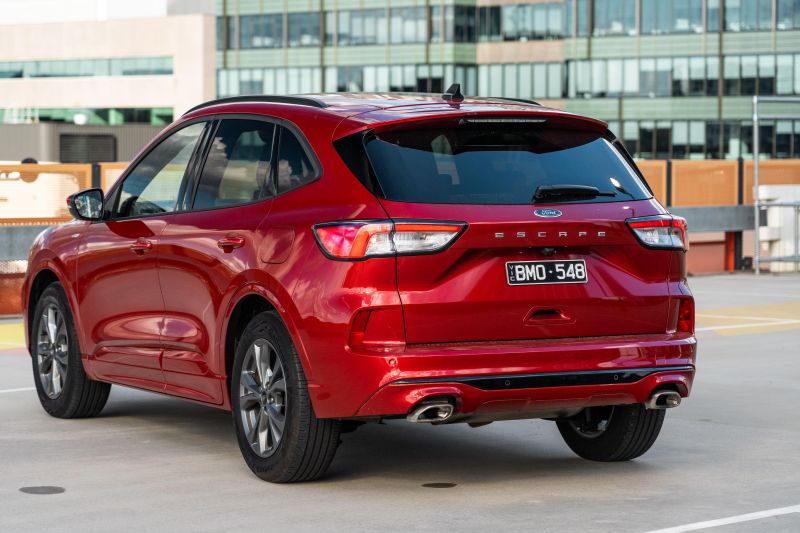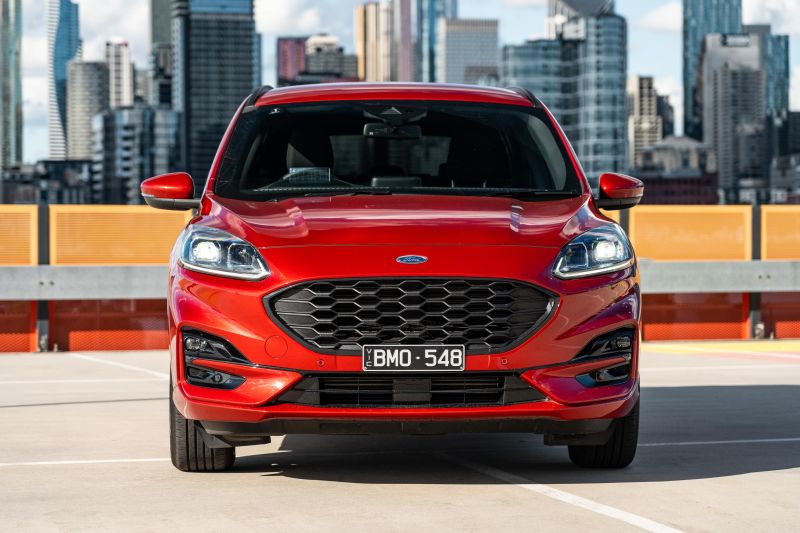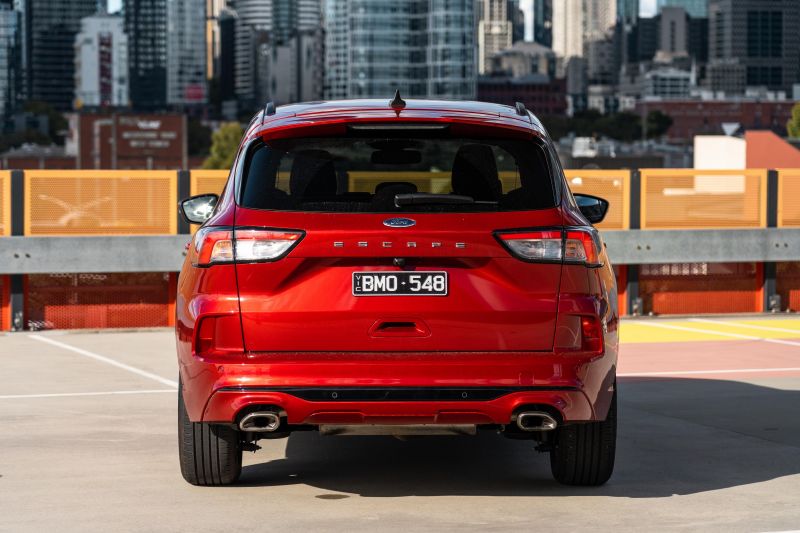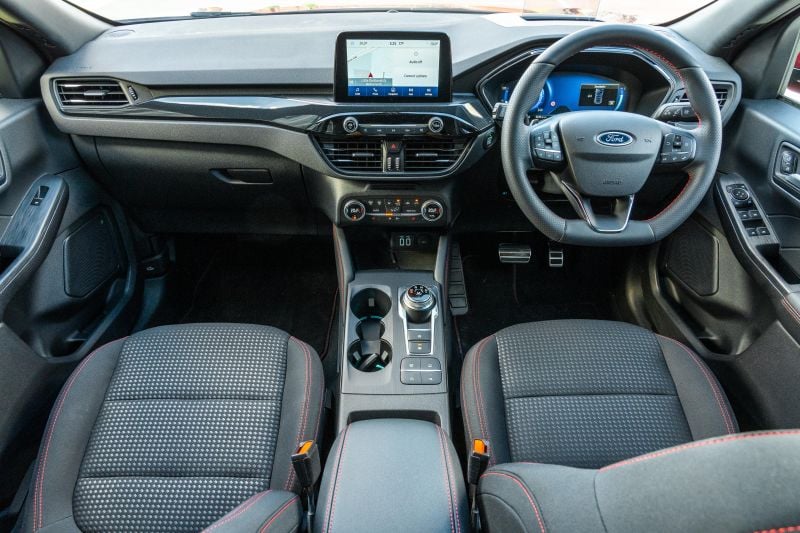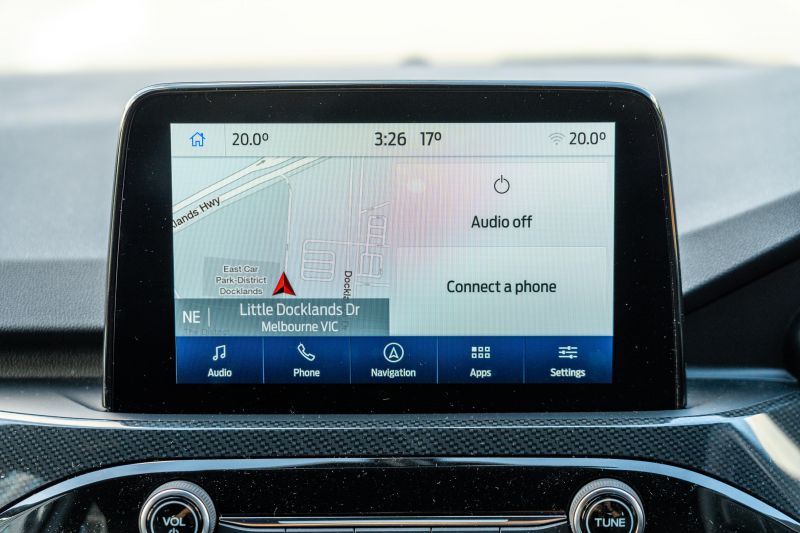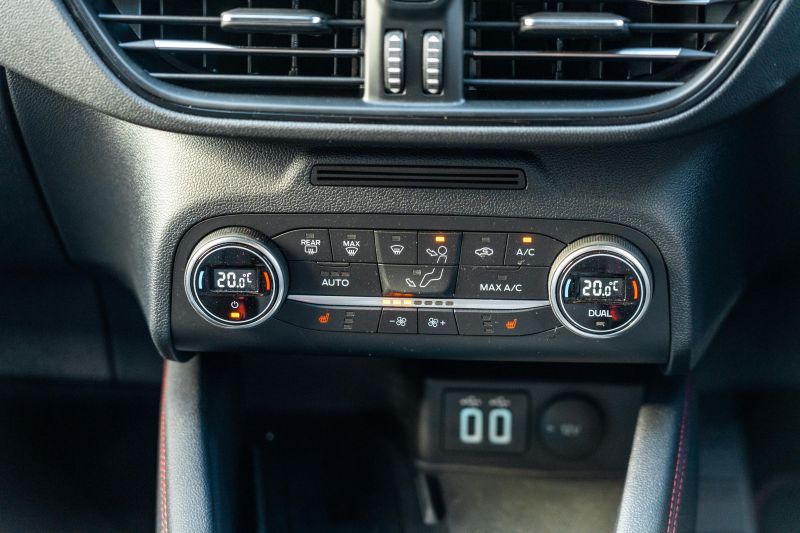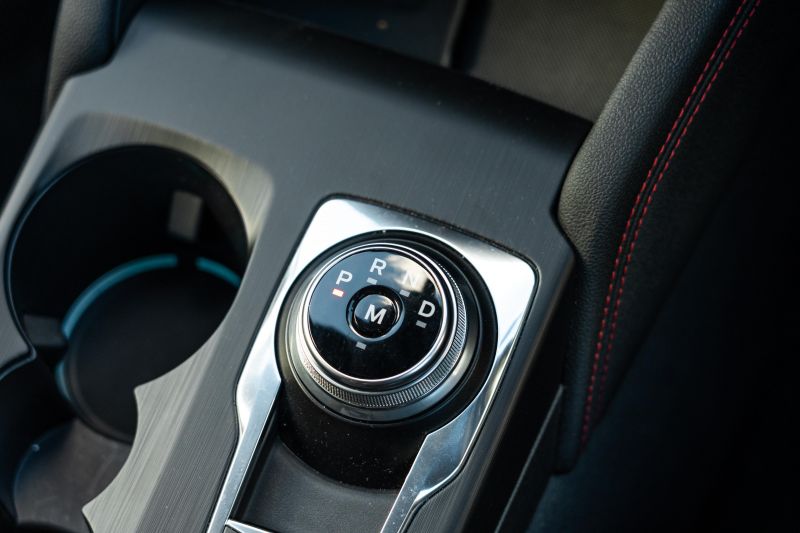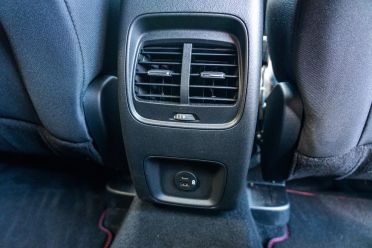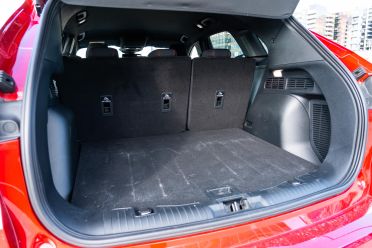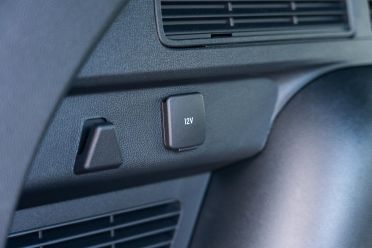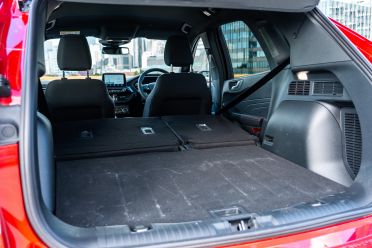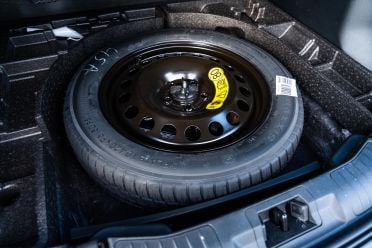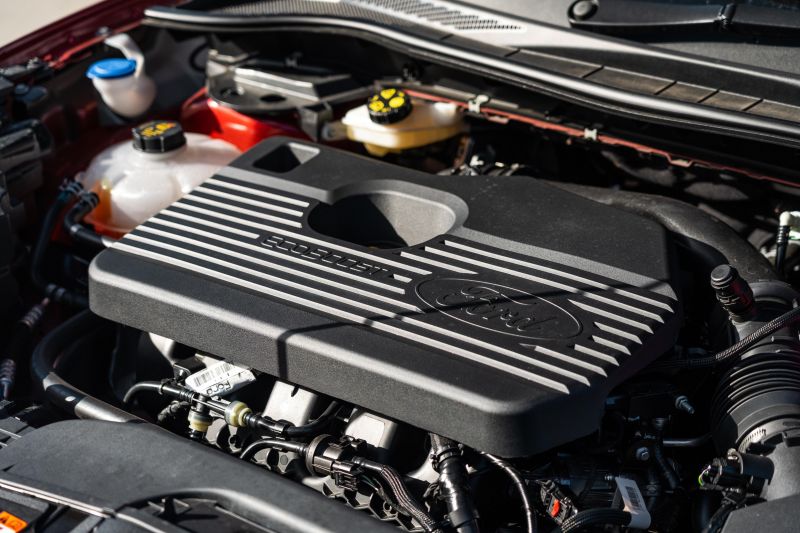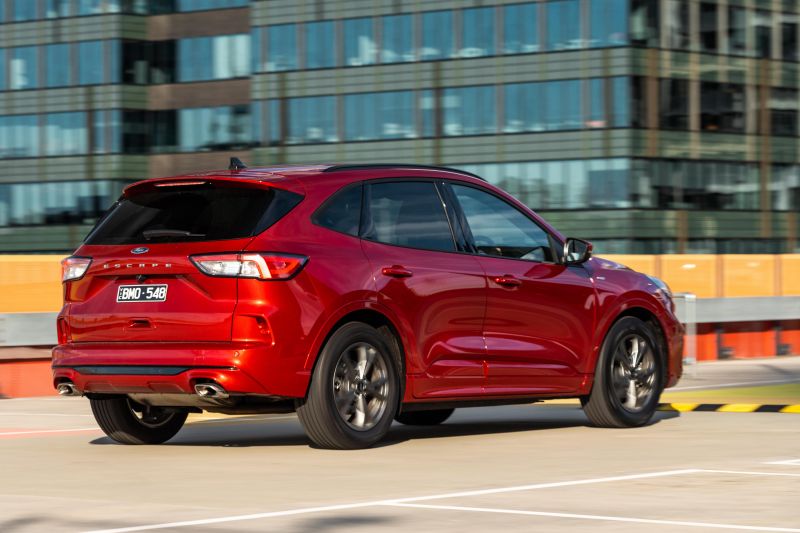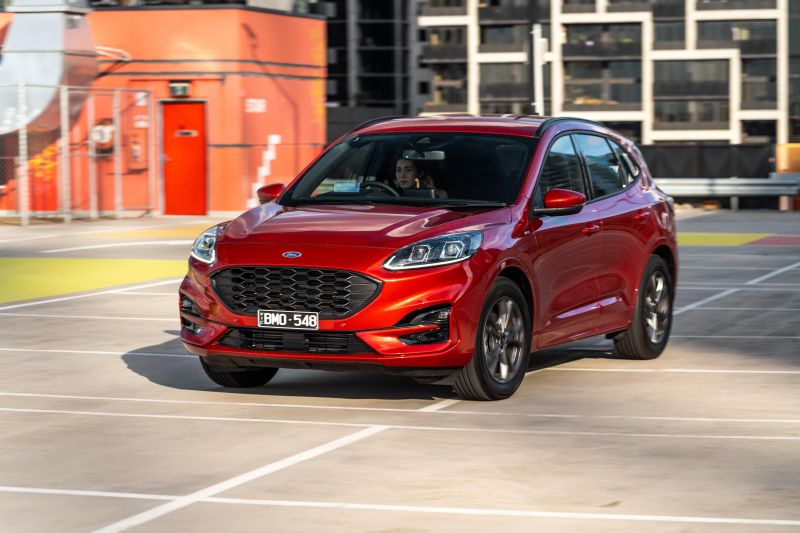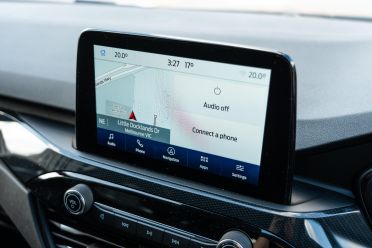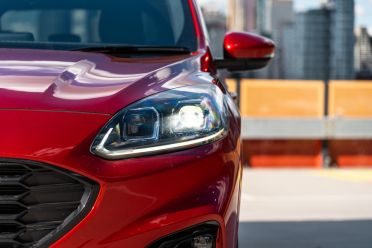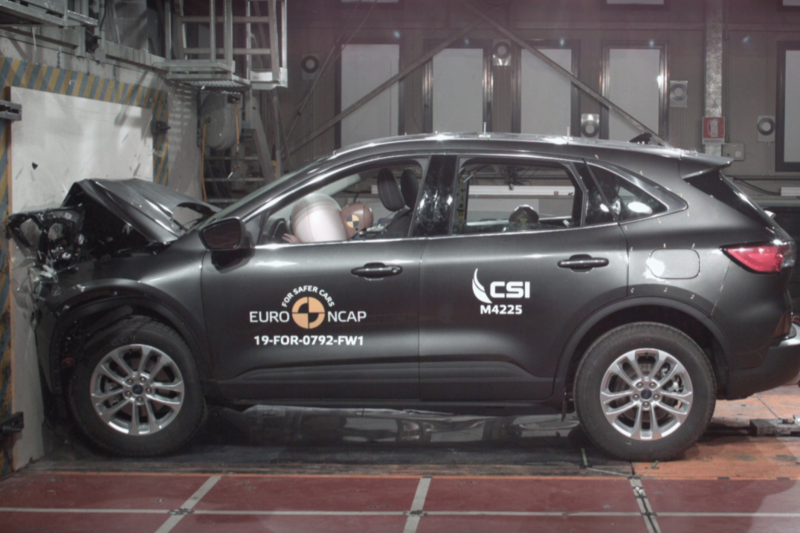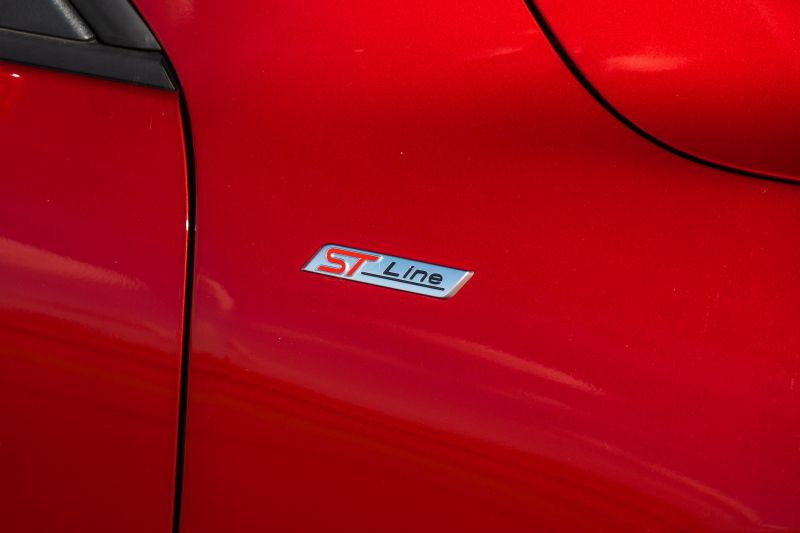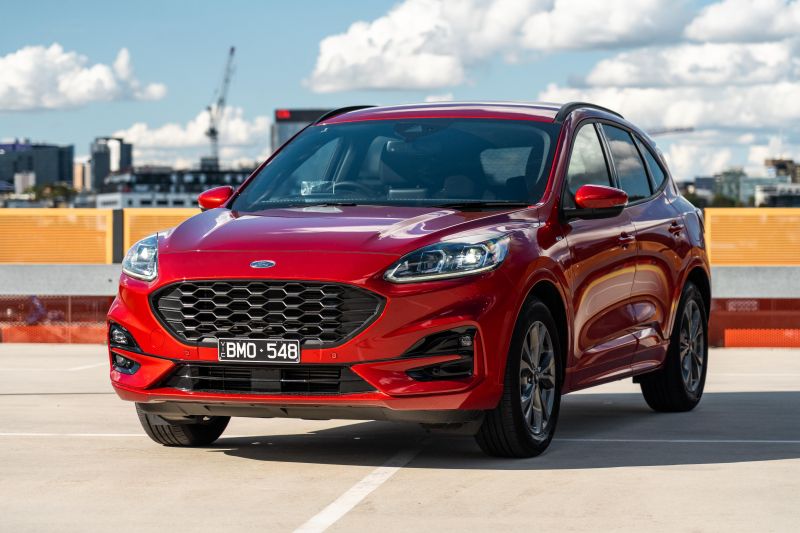The Ford Escape has been a perennial underachiever in Australia, selling in smaller numbers than competitors such as the Toyota RAV4, Mazda CX-5 and Hyundai Tucson.
Is it a bad mid-sized SUV, or just a misunderstood one?
It’s academic at this point, considering Ford Australia has announced it will stop importing the Escape by the end of 2023, leaving it without a vehicle in an incredibly important segment for the time being.
Why has it made such a strange decision? Supply seems to be a key reason, or lack thereof. Ford Australia sources the Escape from a plant in Spain, and the pipeline has been quite limited for years now.
But that doesn’t mean there isn’t need for another review, considering there are still Escapes in dealers. Who knows, you may even scoop one up as a bargain. Should you?

How much does the Ford Escape ST-Line cost?
There are three specification levels to choose from: the base Escape, the ST-Line tested here, and the Vignale luxury variant.
The Escape ST-Line comes with either petrol or plug-in hybrid engines, and in either front- or all-wheel drive. The list pricing is as follows, with our test car in bold.
2023 Ford Escape pricing
- Ford Escape FWD: $37,990
- Ford Escape ST-Line FWD: $39,990
- Ford Escape ST-Line AWD: $42,990
- Ford Escape Vignale FWD: $48,590
- Ford Escape Vignale AWD: $51,590
- Ford Escape ST-Line PHEV FWD: $54,940
Prices exclude on-road costs
Our Ford Escape ST-Line FWD was fitted with the ST-Line Option Pack which takes the list price to $41,940.
For context, it competes with models such as:
- Hyundai Tucson Elite FWD: $39,900
- Kia Sportage SX+ FWD: $41,850
- Mazda CX-5 Maxx Sport FWD: $39,310
- Mitsubishi Outlander LS FWD: $39,740
- Nissan X-Trail ST-L FWD: $43,190
- Subaru Forester 2.5i-L AWD: $40,290
- Toyota RAV4 GXL FWD: $41,600
Prices exclude on-road costs
What is the Ford Escape ST-Line like on the inside?
The Escape comes with a proximity-sensing key fob that unlocks the car as you approach, and unfurls the auto-folding side mirrors.
Climb aboard and you’re presented with a sporty-looking red-stitched wheel with perforated hand grips and a flattened bottom, with logical buttons on each spoke to adjust the cruise control and audio volume (left) and scroll through instrument menus or use voice controls (right).
Unlike many European-sourced vehicles focused predominately on left-hand drive regions, Ford went to the expense of shifting the indicator stalk onto the right-hand side of the steering column.
The instrument cluster is fully digital and measures an expansive 12.3 inches, but slick animations and colour-changing graphics aside it brings little in the way of added functionality. A proper extended map mode for example would have been a nice touch.
Because our Escape test car came with the options package, it also had a head-up display (HUD). But rather than projecting your speed onto the windscreen like most setups it instead uses a small deployable piece of glass. This is an older design.
Ford is clearly going for a slightly sporty feel inside, furnishing the ST-Line with red stitching, patterned cloth trim, metal-capped pedals, and carbon-fibre-look interior trims to break up the dark plastics – some of which are quite hard and scratchy.
If you want an interior to please a more tactile person, then the Mazda CX-5 is a better bet. Even smaller touches like the Ford’s ice blue night-light signatures create a chillier mood – not saying this is good or bad, it’s just the company’s particular design direction.
The centre touchscreen is a mounted tablet that sits right in your line of sight and is easy to reach, but at 8.0 inches in diameter is far smaller than the screens available in most competitors at their higher spec levels. This is simply an older design, and hasn’t had the typical mid-cycle facelift.
Nevertheless even Ford’s older ‘Sync 3’ multimedia software used here is exceptionally user-friendly, with a simple lower toolbar taking you to key menus, and a home screen with maps on the left and two additional tiles/widgets on the right.
It all loads fast and is intuitive to operate, and the embedded modem connects to the FordPass phone app that lets you remotely track your vehicle if you forget where you parked (airport outdoor long-term anyone?), lock and unlock the car, and check car info and diagnostics.
Even the voice commands work relatively well, although I generally used Apple CarPlay (wired only via USB-A ports) and the Siri connection. If you’re an audiophile, note that the Escape ST-Line PHEV and Vignale grades get a 10-speaker B&O system, over our car’s unbranded six-speaker setup.
One issue I had with the screen beyond its rather diminutive size was the reverse-view camera resolution, which is middling at best. Next to some newer multi-view systems out there it just looks a bit dated, but this is from my vantage point as someone who’s always in new cars.
Below the screen sits a bank of buttons and two dials for audio controls, the vents, and then a further series of physical touch points for the dual-zone climate control system. I really like the design trick of putting the two temperature readouts inside each occupant’s rotary dial.
Storage options include an open cubby below the dash with a wireless charging pad, a decent glovebox and centre console (with padded lid/armrest), door bottle holders, and backlit cupholders with teeth along the centre tunnel.
Next to these cupholders are four buttons to turn off the stop/start and parking sensors, retract the HUD, and cycle through available driving modes. The fact none of these functions are buried in stupid touchscreen sub-menus is excellent UX.
There’s also the in-fashion circular transmission dial enabled through shift-by-wire technology. It’s unusual to the uninitiated but saves space, and will automatically turn to P for Park when you stop the car and prepare to exit – just in case you forget.
There’s one major criticism we had regarding the interior design, which deserves its own paragraph. That is the front seats, which do not offer sufficient side and thigh support for a supposedly sporty SUV, and do not drop down low enough.
You almost sit ‘on’ the car rather than ‘in’ the car, if this makes sense, meaning that even if you do feel like testing the sporty steering and punchy engine, you’ll find yourself moving around in your seat too much for comfort.
On the topic of seats, what about the second row?
The back doors don’t open 90 degrees like the super kid-friendly Nissan X-Trail or Honda CR-V, but we’re probably being pedantic, because there’s ample space for two 190cm-plus adults back there – I’m 194cm and sat behind my driving position without issue.
Amenities include rear vents, two USB ports, grab handles, LED lighting, and storage, as well as the requisite top tethers (three, as mandated by ADRs) and ISOFIX anchors (two).
The seatbacks fold down to free up space on a 60:40-split basis, unlike the Mazda CX-5’s cleverer 40:20:40 setup. We’d like a flip-down centre armrest with cupholders, which feels like an odd omission given the price point.
Behind our test vehicle’s optional powered tailgate is a larger-than-average 556-litre boot that expands to 1478L with the back seats folded. There are bag hooks and a 12V outlet back there, and a space-saver spare wheel under the floor.
There’s no third-row seating option like in several competitors, but for a family with two kids the Escape should prove more than capable.
What’s under the bonnet?
The Escape won’t leave performance enthusiasts wanting in terms of acceleration, with its 2.0-litre turbocharged petrol engine putting major competitors in the shade when it comes to power.
The EcoBoost engine makes 183kW and 387Nm, and in our test vehicle drives the front wheels via an eight-speed automatic transmission. All-wheel drive (of the on-demand variety) is an optional extra.
This outstrips other high-performance SUVs such as the Mazda CX-5 G35 Turbo (170kW/420Nm) and Volkswagen Tiguan 162TSI (162kW/350Nm).
You can expect to get from 0-100km/h in about 6.5 seconds. Ford claims a braked towing capacity and 1800kg and combined-cycle fuel economy of 8.6 litres per 100km – acceptable, but not the most frugal in the class either.
There’s no diesel option in Australia, with the only alternative being the plug-in hybrid (PHEV), reviewed here.
How does the Ford Escape ST-Line drive?
Gee it has some punch. If you need to upgrade to a new SUV at your stage of life but have fond memories of punting around in hot hatches and sports coupes, then then Escape is clearly one to consider.
The engine has plenty of low-down torque for rolling response, a sportier drive mode that sharpens accelerator response, and a pretty slick eight-speed automatic with paddle shifters for manual take-over.
It makes the 1.6-litre turbo-petrol in the Hyundai Tucson and Kia Sportage feel a little lacking for example (those two have a diesel as their performance leader), as well as the naturally-aspirated four-cylinder in the Nissan X-Trail and Mitsubishi Outlander.
The trade-off in our cheaper and lighter FWD model is a propensity for the power to overcome the front tyres, resulting in a little bit of torque steer and chirping if you attempt a rapid departure.
The Ford’s fuel efficiency also proved acceptable, with our overall average of 8.5 litres per 100km actually undercutting the manufacturer claim. This was over a 350km combined-cycle driving route including weekly commuting.
The Escape’s suite of driver assists worked pretty well, including the street-sign readout, adaptive cruise control, and lane-keeping aid with steering intervention. The tech suite also did its work without constantly chiming and beeping at you.
In terms of driving dynamics, those unsupportive seats and high-riding driving position discourage you from pushing the limits.
That’s a shame because the steering is highly responsive, and the chassis and suspension tune feels well-sorted – granted, the ST-Line’s “sports-tuned suspension” is a little firm across road imperfections, but it’s neither jarring or overtly unsettled.
It’s important to mention that the ST-Line FWD runs a rear torsion beam suspension layout, whereas the AWD gets a superior multi-link independent rear setup at each end of the axle, which improves roadholding on bad surfaces at a higher pace.
It’s worth stepping up into the AWD if you can, in my opinion.
What do you get?
Escape ST-Line highlights:
- 18-inch alloy wheels
- Space-saver spare wheel
- Power-folding, heated side mirrors
- LED headlights
- LED tail lights
- LED daytime running lights
- Roof rails
- Rain-sensing wipers
- Smart keyless entry
- 12.3-inch instrument cluster
- Auto-dimming rear-view mirror
- Ambient LED interior lighting
- Sensico premium artificial leather wheel
- Cloth seats with unique ST-Line stitching
- Dual-zone climate control
- Floor mats
- 4 x USB ports
- DAB+ receiver
- Six-speaker audio system
- Wireless charging pad
- FordPass Connect modem embed
- 8.0-inch touchscreen
- Apple CarPlay and Android Auto
- Satellite-navigation with live traffic
ST-Line Pack ($1950) adds:
- Adaptive LED headlights
- Powered tailgate
- Heated front seats
- Head-up display (popup)
Colours
- Frozen White – free
- Blazer Blue – free
- Agate Black – free
- Blue Metallic – $700
- Rapid Red – $700
- Magnetic – $700
- Solar Silver – $700
- White Platinum – $700
Is the Ford Escape ST-Line safe?
The Ford Escape wears a five-star ANCAP safety rating, based on testing conducted by Euro NCAP in 2019.
The Escape scored 92 per cent for adult occupant protection, 89 per cent for child occupant protection, 82 per cent for vulnerable road users and 77 per cent for safety assists.
Dual frontal, side chest-protecting and side head-protecting (curtain) airbags are standard on all Escape models.
Standard safety equipment includes:
- AEB incl. Pedestrian, Cyclist detection
- Adaptive cruise control with stop/go
- Blind-spot monitoring
- Rear cross-traffic alert
- Driver impairment monitor
- Lane departure warning
- Lane keep assist
- Front, rear parking sensors
- Reversing camera
- Traffic sign recognition
- Tyre pressure monitor
How much does the Ford Escape ST-Line cost to run?
Ford Australia provides a five-year and unlimited kilometre warranty on all its models.
Capped-price servicing is available, at intervals of 12 months or 15,000km – whichever comes first.
Ford Escape service pricing:
- 12mth/15,000km: $329
- 24mth/30,000km: $329
- 36mth/45,00km: $329
- 48mth/60,000km: $329
- 60mth/75,000km: $320
CarExpert’s Take on the Ford Escape ST-Line
The Ford Escape in its current and previous incarnations never really caught on in Australia, certainly not to the degree of other Fords like the top-selling Ranger and Mustang.
This supply- and demand-led situation is a shame, as is its resultant imminent demise as a new model offering.
Still, if you want a spacious mid-sized SUV with some left-of-centre appeal, ample performance and reasonable value, then the Ford is something to test – if you can find one.
Click the images for the full gallery
MORE: Everything Ford Escape





